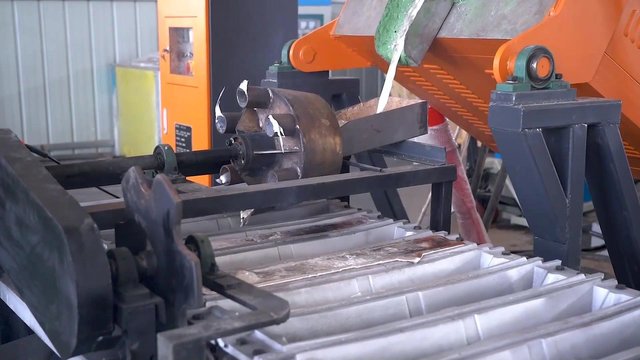Aluminum ingot production line
Email : [email protected]
WeChat/Whatsapp : 86-17538889778
Tel : 86-379-65188091
Main process
Melting aluminum: Melting aluminum raw materials through an aluminum melting furnace (such as the regenerative gas aluminum melting furnace, tower aluminum melting furnace, etc. mentioned above). This is the starting link of the production line and provides liquid aluminum for subsequent ingot casting.
Refining: After aluminum melting, it is sometimes necessary to refine the aluminum liquid. This step is to remove impurities in the aluminum liquid, such as gas (hydrogen, etc.) and solid inclusions (aluminum oxide, etc.). Common refining methods include gas refining (passing chlorine, nitrogen, etc.) and flux refining.
Slag removal: After refining, there will be slag on the surface, and these waste slags need to be removed by slag removal tools to ensure the purity of the aluminum liquid.
Casting: The refined aluminum liquid enters the casting machine. During the casting process, the aluminum liquid cools and solidifies in the mold according to the set shape and size, gradually forming the prototype of the aluminum ingot. After the aluminum ingot is completely solidified, it is demolded and taken out.
- Stacking and packaging: stack the aluminum ingots after demoulding, and then pack them with suitable packaging materials (such as plastic film, steel strip, etc.) for easy transportation and storage.
Main equipment
Aluminum melting furnace: It is the key equipment for melting aluminum. Different types of aluminum melting furnaces have different performances, but the purpose is to melt aluminum raw materials efficiently.
Refining equipment: Generally includes degassing devices and flux adding devices, etc., which are used to remove hydrogen molecules and impurities.
Casting equipment: Aluminum ingots are cast through continuous casting machines, and the aluminum ingot mold determines the shape and size of the aluminum ingot.
Cooling equipment: There are air cooling equipment or water cooling equipment to accelerate the solidification of aluminum ingots.
Stacking and packaging equipment: Like stacking machines or robotic arms for stacking, packaging equipment is used for packaging.
The degree of automation of the entire production line can be adjusted as needed. Highly automated production lines are more efficient and have more stable quality.
- Maintenance and quality control: In order to ensure the smooth operation of the aluminum ingot production line and the quality of the final products, regular maintenance and quality control measures should be implemented. This includes routine inspections of the equipment to identify and address any potential issues, as well as testing the aluminum ingots for impurities and defects. By maintaining the production line and closely monitoring the quality of the aluminum ingots, manufacturers can ensure that they are producing high-quality products that meet industry standards.
- Environmental considerations: The production of aluminum ingots can have environmental impacts, particularly in terms of energy consumption and emissions. Manufacturers should consider implementing sustainable practices to reduce their environmental footprint, such as using energy-efficient equipment, recycling scrap aluminum, and implementing waste management strategies. By taking these steps, manufacturers can minimize their impact on the environment and contribute to a more sustainable industry.
- Market trends and future developments: The aluminum industry is constantly evolving, with new technologies and trends shaping the production of aluminum ingots. Manufacturers should stay informed about market trends and developments in order to remain competitive and meet the demands of customers. This may include investing in new equipment, adopting innovative processes, and exploring new markets for aluminum ingots. By staying ahead of industry trends, manufacturers can position themselves for success in the dynamic aluminum market.
Overall, the production of aluminum ingots is a complex process that requires careful planning, advanced equipment, and a focus on quality and sustainability. By following best practices and staying informed about industry trends, manufacturers can ensure the success of their aluminum ingot production line.
